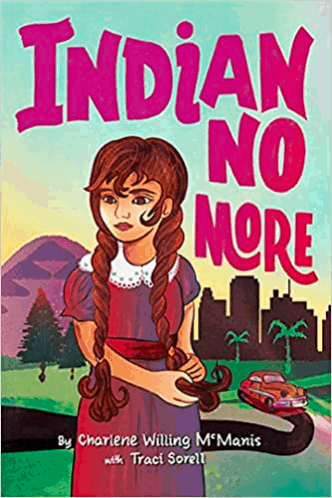
Indian No More by Charlene Willing McManis with Traci Sorell
Suggested ages: 8-12 years
Regina’s family, who belong to the Umpqua tribe, has always lived on the Grand Ronde Indian Reservation in Oregon. Here Regina goes to school, plays in the tall grasses and surrounding forest with her sister, cousins, and friends, and spends time with her grandmother, Chich, listening to her traditional stories. But at the age of 8 unimaginable changes come for her people. In 1954 the Western Oregon Indian Termination Act is passed by Congress. Part of the United States Indian termination policy, it called for an end to federal services and their reservation as a federally recognized trust. The aim is that Indians will abandon their traditions and be assimilated as “Americans.” Soon to follow is the Indian Relocation Act of 1956 which is a voluntary urban relocation program which provides job training. Regina’s father, who works in a logging camp, decides to move his family to Los Angeles where he enrolls in a job training program.
Settling in their home in a foreign neighborhood requires adjustments for all of Regina’s family. Regina navigates her way through this new environment, making friends while at the same time facing stereotypes and misconceptions held by others. Her best friend wants to play “Cowboys and Indians” and introduce her to his favorite TV program, “The Lone Ranger.” Going to a restaurant to celebrate her father’s new job, finds her family experiencing disturbing discrimination in their new home city. Life for Regina is challenging but is also filled with the common childhood joys with friends and family. Regina remembers her Chich’s words, “All that you experienced whether won or lost, was yours” and so she knows that her heritage will always be a proud part of her as she travels, with hope and faith, on new paths in her life.
McManis, the book’s author, is of Umpqua tribal heritage. She based her book on her family’s own experiences when they relocated to Los Angeles after the Indian Relocation Act. The American Indian Youth Literature award for middle grade books selected Indians No More as the winner for 2020.

Gondra’s Treasure by Linda Sue Park, illustrated by Jennifer Black Reinhardt
Suggested ages: 4-7 years
As children grow, they begin to recognize that some of their traits resemble their mother, while others more closely reflect their father. Gondra, a young dragon, muses over just such observations. His mom’s family comes from the West, while his dad’s is from the East. With bemusing vignettes, Gondra explains the differences between Western and Eastern dragons. One breathes fire, the other mist; one flies with the use of wings, the other uses magic. Mom and Dad’s humorous flaunting of their own particular attributes in Gondra’s retelling, is supported by cleverly amusing illustrations. Eventually, Gondra begins to realize that he is a perfect blend of not only his parents, but of other ancestors that came before him. Gondra’s Treasure is a delightful tale, which will be a springboard for families to talk about their own heritage.
Park includes a fascinating author’s note at the end, focusing on the similarities and differences between Eastern and Western dragons. Some cultural anthropologists have suggested that dinosaur skeletons discovered on all Earth’s continents may have given rise to various mythical dragons.

Lift by Minh Lê, illustrated by Dan Santat
Suggested ages: 4-8 years
It takes only a girl, an elevator and a button to be magically transported to new worlds! Whenever Iris feels “a bit down,” the one thing that perks her up is pushing the elevator buttons in her family’s apartment building. But then one day her little brother is given this privilege and Iris feels “betrayed!” A tantrum ensues which in the end leaves the old elevator button to be discovered later in the trash. Iris retrieves it and finds new worlds opening up – a shadowy jungle or the vastness of outer space. Her explorations are solitary and secret until she realizes that shared adventures are by far superior. “After all, everyone can use a lift sometimes.”
Lift unfurls as a graphic novel picture book. Iris’s story is told in dynamic comic style panels along with speech bubbles and her occasional narration. Children will be mesmerized as they join Iris on her “journey” and will find themselves revisiting Lift again and again.
